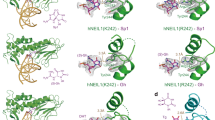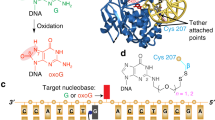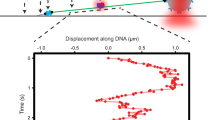Abstract
Most spontaneous damage to bases in DNA is corrected through the action of the base-excision DNA repair pathway. Base excision repair is initiated by DNA glycosylases, lesion-specific enzymes that intercept aberrant bases in DNA and catalyze their excision. How such proteins accomplish the feat of catalyzing no fewer than five sequential reaction steps using a single active site has been unknown. To help answer this, we report the structure of a trapped catalytic intermediate in DNA repair by human 8-oxoguanine DNA glycosylase. This structure and supporting biochemical results reveal that the enzyme sequesters the excised lesion base and exploits it as a cofactor to participate in catalysis. To our knowledge, the present example represents the first documented case of product-assisted catalysis in an enzyme-catalyzed reaction.
This is a preview of subscription content, access via your institution
Access options
Subscribe to this journal
Receive 12 print issues and online access
$189.00 per year
only $15.75 per issue
Buy this article
- Purchase on Springer Link
- Instant access to full article PDF
Prices may be subject to local taxes which are calculated during checkout







Similar content being viewed by others
References
Lindahl, T. & Wood, R.D. Quality control by DNA repair. Science 286, 1897–1905 (1999).
Krokan, H.E., Standal, R. & Slupphaug, G. DNA glycosylases in the base excision repair of DNA. Biochem. J. 325, 1–16 (1997).
Schärer, O.D. & Jiricny, J. Recent progress in the biology, chemistry and structural biology of DNA glycosylases. Bioessays 23, 270–281 (2001).
Dodson, M.L., Michaels, M.L. & Lloyd, R.S. Unified catalytic mechanism for DNA glycosylases. J. Biol. Chem. 269, 32709–32712 (1994).
Weiss, B. & Grossman, L. Phosphodiesterases involved in DNA repair. Adv. Enzymol. Relat. Areas Mol. Biol. 60, 1–34 (1987).
Sun, B., Latham, K.A., Dodson, M.L. & Lloyd, R.S. Studies on the catalytic mechanism of five DNA glycosylases. Probing for enzyme-DNA imino intermediates. J. Biol. Chem. 270, 19501–19508 (1995).
Nash, H.M. et al. Cloning of a yeast 8-oxoguanine DNA glycosylase reveals the existence of a base-excision DNA-repair protein superfamily. Curr. Biol. 6, 968–980 (1996).
Bruner, S.D., Nash, H.M., Lane, W.S. & Verdine, G.L. Repair of oxidatively damaged guanine in Saccharomyces cerevisiae by an alternative pathway. Curr. Biol. 8, 393–403 (1998).
Piersen, C.E., Prince, M.A., Augustine, M.L., Dodson, M.L. & Lloyd, R.S. Purification and cloning of Micrococcus luteus ultraviolet endonuclease, an N-glycosylase/abasic lyase that proceeds via an imino enzyme-DNA intermediate. J. Biol. Chem. 270, 23475–23484 (1995).
Nash, H.M., Lu, R., Lane, W.S. & Verdine, G.L. The critical active-site amine of the human 8-oxoguanine DNA glycosylase, hOgg1: direct identification, ablation and chemical reconstitution. Chem. Biol. 4, 693–702 (1997).
Zharkov, D.O., Rieger, R.A., Iden, C.R. & Grollman, A.P. NH2-terminal proline acts as a nucleophile in the glycosylase/AP-lyase reaction catalyzed by Escherichia coli formamidopyrimidine-DNA glycosylase (Fpg) protein. J. Biol. Chem. 272, 5335–5341 (1997).
Lu, R., Nash, H.M. & Verdine, G.L. A mammalian DNA repair enzyme that excises oxidatively damaged guanines maps to a locus frequently lost in lung cancer. Curr. Biol. 7, 397–407 (1997).
Arai, K. et al. Cloning of a human homolog of the yeast OGG1 gene that is involved in the repair of oxidative DNA damage. Oncogene 14, 2857–2861 (1997).
Roldan-Arjona, T. et al. Molecular cloning and functional expression of a human cDNA encoding the antimutator enzyme 8-hydroxyguanine-DNA glycosylase. Proc. Natl. Acad. Sci. USA 94, 8016–8020 (1997).
Bjoras, M. et al. Opposite base-dependent reactions of a human base excision repair enzyme on DNA containing 7,8-dihydro-8-oxoguanine and abasic sites. EMBO J. 16, 6314–6322 (1997).
Rosenquist, T.A., Zharkov, D.O. & Grollman, A.P. Cloning and characterization of a mammalian 8-oxoguanine DNA glycosylase. Proc. Natl. Acad. Sci. USA 94, 7429–7434 (1997).
Radicella, J.P., Dherin, C., Desmaze, C., Fox, M.S. & Boiteux, S. Cloning and characterization of hOGG1, a human homolog of the OGG1 gene of Saccharomyces cerevisiae. Proc. Natl. Acad. Sci. USA 94, 8010–8015 (1997).
Kuo, F.C. & Sklar, J. Augmented expression of a human gene for 8-oxoguanine DNA glycosylase (MutM) in B lymphocytes of the dark zone in lymph node germinal centers. J. Exp. Med. 186, 1547–1556 (1997).
Aburatani, H. et al. Cloning and characterization of mammalian 8-hydroxyguanine-specific DNA glycosylase/apurinic, apyrimidinic lyase, a functional mutM homologue. Cancer Res. 57, 2151–2156 (1997).
Marnett, L.J. Oxyradicals and DNA damage. Carcinogenesis 21, 361–370 (2000).
Bruner, S.D., Norman, D.P. & Verdine, G.L. Structural basis for recognition and repair of the endogenous mutagen 8-oxoguanine in DNA. Nature 403, 859–866 (2000).
Norman, D.P.G., Bruner, S.D. & Verdine, G.L. Coupling of substrate recognition and catalysis by a human base-excision DNA repair protein. J. Am. Chem. Soc. 123, 359–360 (2001).
Labahn, J. et al. Structural basis for the excision repair of alkylation-damaged DNA. Cell 86, 321–329 (1996).
Thayer, M.M., Ahern, H., Xing, D., Cunningham, R.P. & Tainer, J.A. Novel DNA binding motifs in the DNA repair enzyme endonuclease III crystal structure. EMBO J. 14, 4108–4120 (1995).
Wright, P.M., Yu, J., Cillo, J. & Lu, A.L. The active site of the Escherichia coli MutY DNA adenine glycosylase. J. Biol. Chem. 274, 29011–29018 (1999).
Norman, D.P.G., Chung, S.J. & Verdine, G.L. Structural and biochemical exploration of a critical amino acid in human 8-oxoguanine glycosylase. Biochemistry, advance online publication, 24 January 2003 (DOI 10.1021/bi026823d).
Hollis, T., Ichikawa, Y. & Ellenberger, T. DNA bending and a flip-out mechanism for base excision by the helix-hairpin-helix DNA glycosylase, Escherichia coli AlkA. EMBO J. 19, 758–766 (2000).
Zharkov, D.O., Rosenquist, T.A., Gerchman, S.E. & Grollman, A.P. Substrate specificity and reaction mechanism of murine 8-oxoguanine-DNA glycosylase. J. Biol. Chem. 275, 28607–28617 (2000).
Mazumder, A. et al. Stereochemical studies of the β-elimination reactions at aldehydic abasic sites in DNA: endonuclease III from Escherichia coli, sodium hydroxide, and Lys-Trp-Lys. Biochemistry 30, 1119–1126 (1991).
Creighton, T.E. Proteins (Freeman, New York; 1993).
Drohat, A.C. & Stivers, J.T. NMR evidence for an unusually low N1 pKa for uracil bound to uracil DNA glycosylase: implications for catalysis. J. Am. Chem. Soc. 122, 1840–1841 (2000).
Dall'Acqua, W. & Carter, P. Substrate-assisted catalysis: molecular basis and biological significance. Protein Sci. 9, 1–9 (2000).
Widlanski, T.S., Bender, S.L. & Knowles, J.R. Dehydroquinate synthase: a sheep in wolf's clothing? J. Am. Chem. Soc. 111, 2299–2300 (1989).
Otwinowski, Z. & Minor, W.M. Processing of X-ray diffraction data collected in oscillation mode. Methods Enzymol. 276, 307–326 (1997).
Brunger, A.T. et al. Crystallography & NMR system: a new software suite for macromolecular structure determination. Acta Crystallogr. D 54, 905–921 (1998).
Brunella, A. & Ghisalba, O. Recombinant Lactobacillus leichmannii ribonucleosidetriphosphate reductase as a biocatalyst in the preparative synthesis of 2′-deoxyribonucleoside-5′-triphosphates. J. Mol. Cat. B Enzym. 10, 215–222 (2000).
Brunger, A.T. & Karplus, M. Polar hydrogen positions in proteins: empirical energy placement and neutron diffraction comparison. Proteins 4, 1481–1456 (1988).
Schaefer, M., Sommer, M. & Karplus, M. pH-dependence of protein stability: absolute electrostatic free energy differences between conformations. J. Phys. Chem. B 101, 1663–1683 (1997).
MacKerell, A.D. Jr. et al. All-atom empirical potential for molecular modeling and dynamics studies of proteins. J. Phys. Chem. B 102, 3586–3616 (1998).
Bayly, C.I., Cieplak, P., Cornell, W. & Kollman, P.A. A well-behaved electrostatic potential based method using charge restraints for deriving atomic charges: the RESP model. J. Phys. Chem. 97, 10269–10280 (1993).
Brooks, C.L. III, Brunger, A.T. & Karplus, M. Active site dynamics in protein molecules: a stochastic boundary molecular-dynamics approach. Biopolymers 24, 843–865 (1985).
Simonson, T., Archontis, G. & Karplus, M. Continuum treatment of long-range interactions in free energy calculations. Application to protein-ligand binding. J. Phys. Chem. B 101, 8347–8360 (1997).
Brooks, C.L. III & Karplus, M. Deformable stochastic boundaries in molecular dynamics. J. Chem. Phys. 79, 6312–6325 (1983).
Stote, R.H., States, D.J. & Karplus, M. On the treatment of electrostatic interactions in biomolecular simulation. J. Chim. Phys. Phys.-Chim. Biol. 88, 2419–2433 (1991).
Steinbach, P.J. & Brooks, B.R. New spherical-cutoff methods for long-range forces in macromolecular simulation. J. Comput. Chem. 15, 667–683 (1994).
Kumar, S., Bouzida, D., Swendsen, R.H., Kollman, P.A. & Rosenberg, J.M. The weighted histogram analysis method for free-energy calculations on biomolecules. I. The method. J. Comput. Chem. 13, 1011–1021 (1992).
Fletcher, R. & Powell, M.J.D. A rapidly convergent descent method for minimization. Comput. J. 6, 163 (1963).
Read, R.J. Improved Fourier coefficients for maps using phases from partial structures with errors. Acta Crystallogr. A 42, 104–149 (1986).
Acknowledgements
Use of the Argonne National Laboratory Structural Biology Center beamlines at the Advanced Photon Source was supported by the U.S. Department of Energy, Office of Biological and Environmental Research. J.C.F. was supported by an NIH BCMB training grant and by a Graduate Research Fellowship from the NSF. S.D.B is an Eli Lilly Fellow. We are grateful to D.P.G. Norman for assistance with data collection and processing and for helpful discussions. We thank C. Heaton and the entire MacCHESS staff for assistance with data collection. R. Sanishvili, S. Korolev, S. Ginell and A. Joachimak of SBC-CAT at the Advanced Photon Source, Argonne National Laboratory provided valuable advice and assistance.
Author information
Authors and Affiliations
Corresponding author
Ethics declarations
Competing interests
The authors declare no competing financial interests.
Rights and permissions
About this article
Cite this article
Fromme, J., Bruner, S., Yang, W. et al. Product-assisted catalysis in base-excision DNA repair. Nat Struct Mol Biol 10, 204–211 (2003). https://doi.org/10.1038/nsb902
Received:
Accepted:
Published:
Issue Date:
DOI: https://doi.org/10.1038/nsb902
This article is cited by
-
Crystal structure and DNA cleavage mechanism of the restriction DNA glycosylase R.CcoLI from Campylobacter coli
Scientific Reports (2021)
-
Modular Protein Ligation: A New Paradigm as a Reagent Platform for Pre-Clinical Drug Discovery
Scientific Reports (2019)
-
The roles of base excision repair enzyme OGG1 in gene expression
Cellular and Molecular Life Sciences (2018)
-
DNA glycosylases: in DNA repair and beyond
Chromosoma (2012)
-
Structure of a repair enzyme interrogating undamaged DNA elucidates recognition of damaged DNA
Nature (2005)



